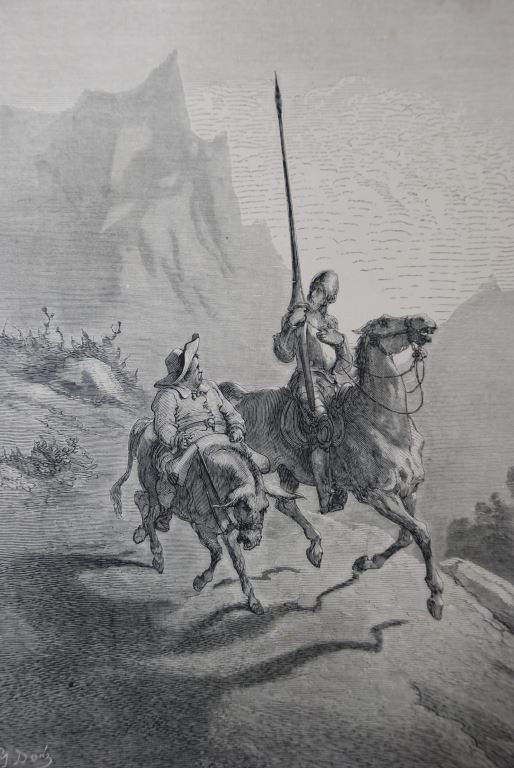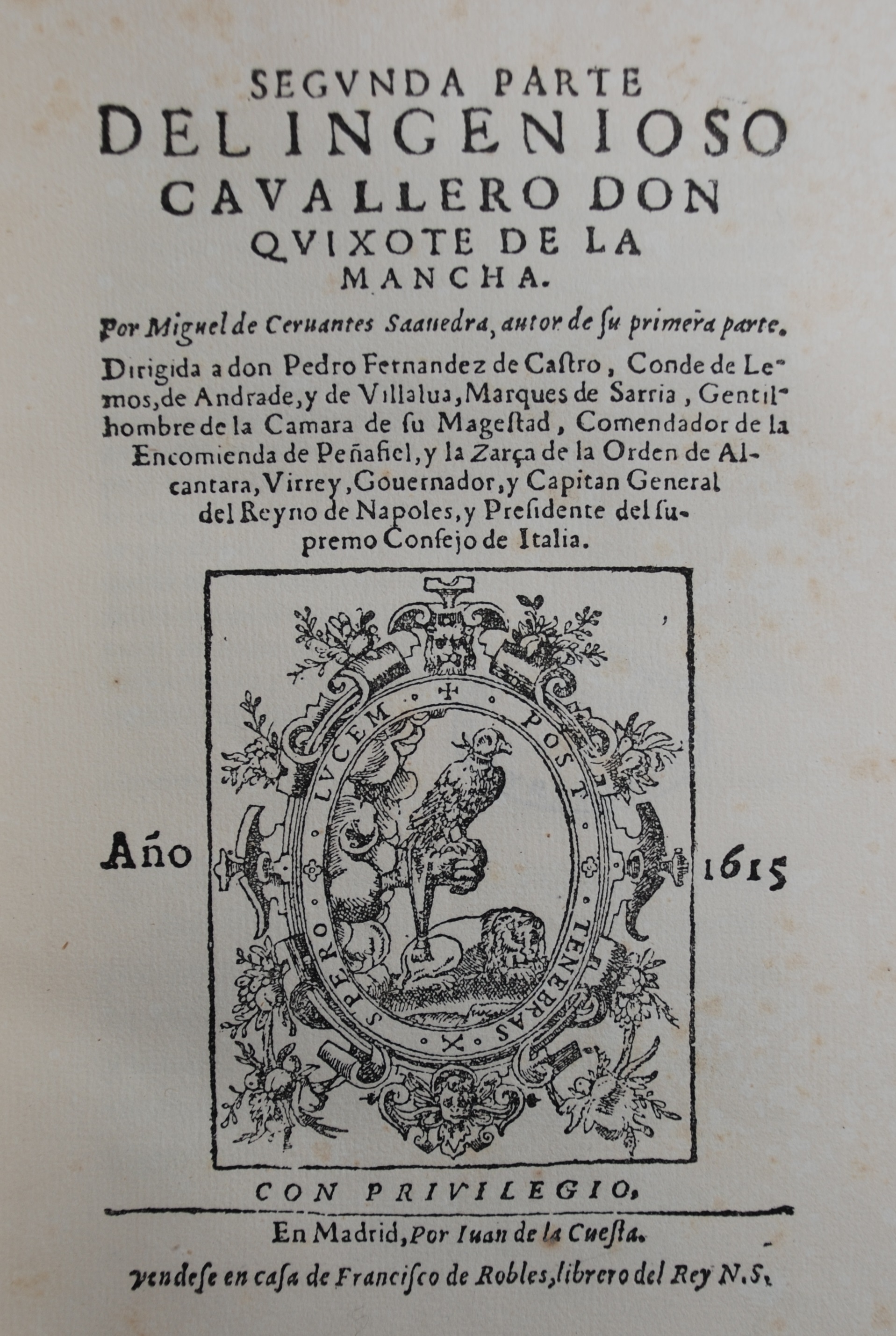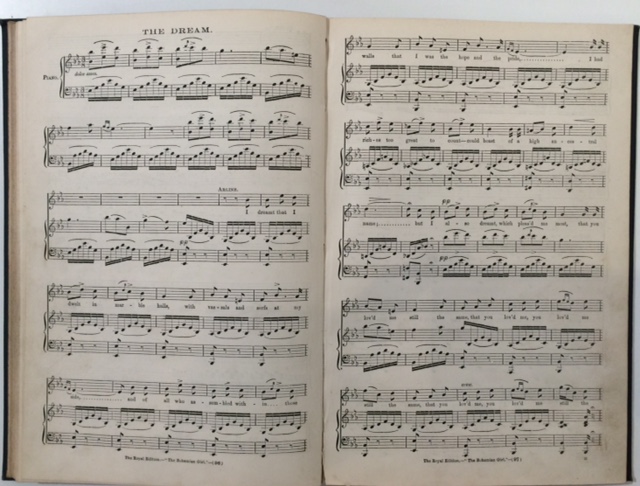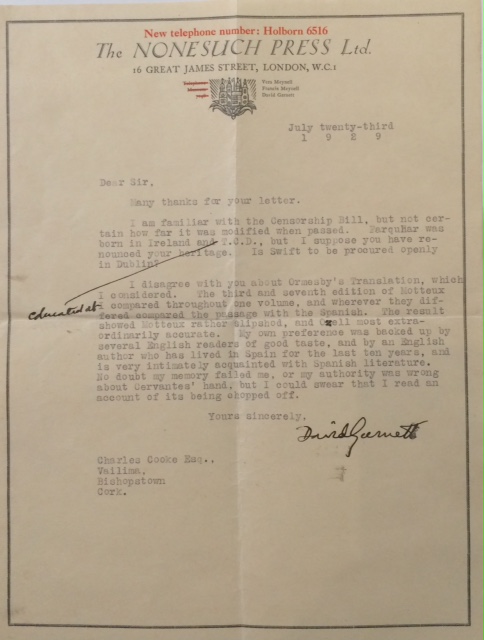Cervantes ‘Prince of Wits’: A Printed Legacy
- Elaine Harrington
- July 20, 2016
This year we celebrate the 400th anniversaries of the deaths of two literary geniuses: Shakespeare (died 3 May 1616 in Stratford-upon-Avon) and Cervantes (died 22 April 1616 in Madrid). To mark Cervantes’ anniversary UCC Library in conjunction with the Dept. of Spanish, Portuguese and Latin American Studies in UCC is running an exhibition entitled “Cervantes ‘Prince of Wits’ (1616 – 2016): Life, Work, Legacy.” The exhibition will run until 16 September 2016.This post is the first of two on the exhibition and focuses on the material that is currently on display in the exhibition cases on Q floor. Stephen Boyd, the initiator of the exhibition, will discuss next month how he created the exhibition and what concerns may face anyone considering creating their own exhibition.
Choosing the Material
Stephen and I chose the material to place on display in part based on:
- the condition of the material
- how we felt the material would look within the exhibition cases
- how we felt the material would best sit within the narrative of the display
Some material was bound exceptionally tightly which means the item cannot be opened further than 30° – 45°. Material of this nature is difficult to view. Material that didn’t have interesting images, relevant provenance or a local connection was rejected. Items that were non-textual such as music scores were included. Much of the material chosen for the exhibition cases contains items from William Cooke’s collection. Cooke (1865-1955) was the first lecturer of Spanish in UCC (1911 – 1938) and his collection represents his extensive interest in travel, biography and the history of America, Latin America, and Spain. Further details on William Cooke may be found in UCC Record 31 Easter 1956.
El Ingenioso hidalgo Don Quijote de la Mancha
El ingenioso hidalgo don Quijote de la Mancha, or as we know it Don Quixote, was first published in two volumes between 1605 and 1615. In front of the exhibition title is an exhibition case containing a facsimile edition by Francisco López Fabra of the first edition of El ingenioso hidalgo don Quijote de la Mancha. This is la primera edición el Ingenioso hidalgo Don Quijote de la Mancha. The work has two volumes and was published in Barcelona, 1871-79. The facsimile is open to the title page of the first edition of Don Quixote II which was published in Madrid in 1615. The title page shows the printer Juan de la Cuesta’s emblem, and motto, ‘Post tenebras spero lucem’ (‘After darkness, I hope for light’; Job 12, 17).
English Translations of Don Quixote
In 1612 Thomas Shelton (1604–1620) was the first person to translate Don Quixote I into English as The History of Don Quixote of the Mancha. Indeed this was the first translation into any language. It could have been read by Shakespeare (1564-1616) and some scholars believe that it was. Shelton didn’t use any of the authorised editions for his translation; instead he used an edition published in 1607 in Brussels which was then part of the Spanish Netherlands. Shelton’s translation Don Quixote II appeared in 1620.
In 1755 a different translation was completed by Tobias Smollett (1721 – 1771). Smollett translated Cervantes’ work as The History and Adventures of the Renowned Don Quixote in a work that spans four volumes. UCC Library holds a Dublin printing (1783) of this translation, but only of volume 3. This Dublin printer was Daniel Graisberry and he operated from the 1770s to his death in 1785 whereupon his wife and later their son ran the Graisberry printing firm.
Other Works by Cervantes
In 1585 Cervantes published a pastoral novel Galatea. However it was during the last nine years of his life that his reputation as a writer was solidified. During this period he published:
- 1613: Novelas ejemplares (Exxemplary Novels)
- 1614: Journey to Parnassus (Viaje al Parnaso)
- 1615: the second part of Don Quixote and the Ocho comedias y ocho entremeses.
- 1617: posthumous publication of Los trabajos de Persiles y Sigismunda: Historia setentrional (The Works of Persiles and Sigismunda)
On display are a 1743 Antwerp printing of Novelas exemplares and a 1802 printing of Trabajos de Persiles y Sigismunda. Novelas exemplares is bound in half calf with gold tooling on the spine and with marbled endpapers. Cervantes’s only allusions to Ireland appear in his last work as in one passage (from I, 12), the Irish astrologer, Mauricio, describes a Hibernian version of the ius primae noctis.
Musical Items Inspired by Cervantes’ Work
Charles Dibdin’s (1745 –1814) The Padlock: A Comic Opera As It Is Performed at the Theatre Royal in Drury Lane (1768) contains a libretto by Isaac Bickerstaffe. The libretto is based on Cervantes’s ‘The Jealous Extremaduran’ (‘El celoso estremeño,’ Exemplary Tales, 1613) and is the story of an elderly, obsessively jealous husband who keeps his young wife under lock and key. The opera’s title comes from the large padlock that the old man keeps on the cottage door.
The Irish composer Michael William Balfe (1808- 1870) loosely based The Bohemian Girl: An Opera in Three Acts on Cervantes’ ‘The Little Gypsy Girl’ (‘Preciosa,’ Exemplary Tales, 1613). The opera was first performed at the Theatre Royal on Drury Lane, London in 1843 and is best known for its aria ‘I Dreamt I Dwelt in Marble Halls’. The aria is sung by the character Arline, who is in love with Thaddeus, a Polish nobleman and political exile. Listen to ‘I Dreamt I Dwelt in Marble Halls’ here. Although Balfe composed at least 29 operas, almost 250 songs and other works, The Bohemian Girl was his most popular work and productions of it ran throughout Europe and America. Subsequently it was translated into French and Italian.
Cork Connections to Don Quixote
An t-Athair Peadar Ua Laoghaire (1839 – 1920) is regarded as a pioneering writer in modern Irish and was born outside of Macroom, Co. Cork. His best known works are Séadna (1904) and Mo Scéal Féin (1915). In 1921 Don Cíochóté was one of Ua Laoghaire’s last published works and it is a partial and considerably bowdlerized Irish-language version of Don Quixote I. It is the only Irish version to date. In 2001 Don Cíochóté was reprinted with Gabriel Rosenstock writing an introduction to the 1921 translation.
In 1930 the Nonesuch Press published a translation by Peter Motteux, originally written in 1743, of Don Quixote de la Mancha. Edward McKnight Kauffer provided illustrations for the volumes. The Nonesuch edition of Don Quixote de la Mancha is in two volumes and consists of 1475 copies; The copy in UCC Library is number 615 and is part of William Cooke’s collection. Inside the first volume of Don Quixote de la Mancha was found a letter (of 23 July 1929) from David Garnett, co-founder of the Nonesuch Press, to Charles Cooke, Esq., Vailima, Bishopstown, Cork referring to the Censorship Bill and comparing translations by Ormesby, Motteux and Ozell.
Dr Hiram Morgan, School of History, UCC kindly lent his copy of Philip O’Sullivan Beare’s Historiae Catholicae Iberniae Compendium published in Lisbon in 1621 for the exhibition. The item is better known as O’Sullivan’s Catholic History and is one of the most important polemical works of Irish political thought published in the early modern period. The intention was to provide Catholic dissidents at home and abroad with an interpretation of Irish history and of their contemporary difficulties by establishing Ireland’s unique contribution to Catholicism and showing how it had been wrecked by the English misrule. The solution propounded was a Spanish conquest by the new king, Philip IV, to whom O’Sullivan dedicated the book. Philip IV reigned during the publication of Cervantes’ Don Quixote. O’Sullivan wished Philip IV to answer his true calling by recognising the terrible plight of Irish Catholics and to liberate their country. The solution propounded was a Spanish conquest by the new king, Philip IV, to whom O’Sullivan dedicated the book. Philip III, Philip IV’s predecessor, had reigned during the publication of Cervantes’ Don Quixote and O’Sullivan Beare would have compiled his Compendium at that time. O’Sullivan wished Philip IV to answer his true calling by recognising the terrible plight of Irish Catholics and to liberate their country. To this end O’Sullivan made much of Irish connections with Iberia including the famous myth that the Irish were descended from King Milesius of Northern Spain. In doing so he emphasized the sufferings of his own family at the hands of English heretics – providing the epic account of his cousin Donal Cam’s retreat from Bantry Bay to Breifne – and, afterwards in exile, their military services to the Spanish crown.
“Cervantes ‘Prince of Wits’ (1616 – 2016): Life, Work, Legacy” runs until 16 September 2016.
Note: Within The Oxford Dictionary of National Biography are biographies of Thomas Shelton, Tobias Smollett, Charles Dibdin, Michael Williams Balfe and Peter Motteux. Within The Dictionary of Irish Biography are biographies of Michael Williams Balfe and Peadar Ua Laoghaire as ‘Peadar Ó Laoghaire.’
References
Cervantes Saavedra, Miguel de. La primera edición del Ingenioso hidalgo Don Quijote de la Mancha. Facsimile edition by Francisco López Fabra. Notes by Juan Hartzenbusch. 2 vols. Barcelona: 1871-79.
Cervantes Saavedra, Miguel de. Novelas exemplares. 2 vols. Antwerp: Bousquet, 1743.
Cervantes Saavedra, Miguel de. The History and Adventures of the Renowned Don Quixote. Trans. T. Smollett. Vol 3. Dublin: D. Graisberry, 1783.
Cervantes Saavedra, Miguel de. Trabajos de Persiles y Sigismunda: Historia setentrional. 2 vols. Madrid: En la Imprenta de Sancha, 1802.
Cervantes Saavedra, Miguel de. The History of Don Quixote of the Mancha. Trans. Thomas Shelton. Reprinted from the 1st ed., 1612-1620, with a new preface by F.J. Harvey Darton. 2 vols. London: Navarre Society, 1923.
Cervantes Saavedra, Miguel de. Don Quixote de la Mancha. Trans. Peter Motteux. Rev. J. Ozell (1743). Illustrated by Edward McKnight Kauffer. 2 vols. London: Nonesuch Press, 1930.
Cervantes Saavedra, Miguel de. The History of Don Quixote. Text ed. J. W. Clark; Illust. Gustave Doré. New York : Cassell, [1880?].
Balfe, M. W. The Bohemian Girl: An Opera in Three Acts. Words by Alfred Bunn. Ed. Arthur Sullivan and J. Pittman. London: Bosey; New York: William A. Pont, c. [18–].
Cervantes, Miguel de. Don Cíochóté. Trans. An t-Athair Peadar Ua Laoghaire. Baile Átha Cliath: Brún agus Ó Nóláin, 1922.
Cervantes, Miguel de. Don Cíochótae. An t-Athair Peadar Ó Laoghaire a d’astrigh agus a ghiorraigh; eagarthóir, Gabriel Rosenstock. Baile Átha Cliath: Cló Thalbóid, 2001.
Dibdin, Charles. The Padlock: A Comic Opera As It Is Performed at the Theatre Royal in Drury Lane. London: Printed for the author & sold by J. Johnston, [176-?].
Letter (of 23 July 1929) from David Garnett, co-founder of the Nonesuch Press, to Charles Cooke. Inserted into Don Quixote de la Mancha. Trans. Peter Motteux. Rev. J. Ozell (1743). Illustrated by Edward McKnight Kauffer. 2 vols. London: Nonesuch Press, 1930.
O’Sullivan Beare, Philip. Historiae Catholicae Iberniae Compendium [Compendium of the Catholic History of Ireland]. Lisbon, 1621. On loan from Dr. Hiram Horgan, School of History, UCC.








